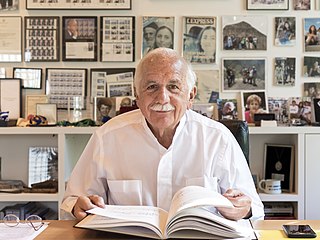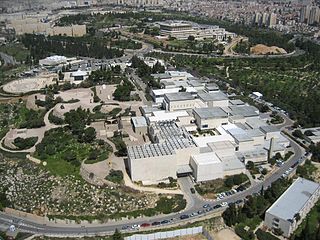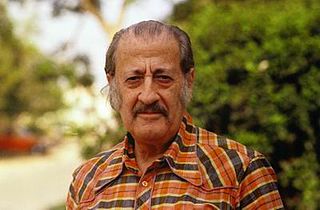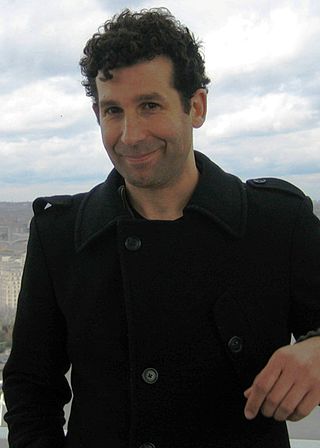Related Research Articles

Moshe Safdie is an architect, urban planner, educator, theorist, and author, with Israeli, Canadian, and American citizenship. He is known for incorporating principles of socially responsible design in his 50-year career. His projects include cultural, educational, and civic institutions; neighborhoods and public parks; housing; mixed-use urban centers; airports; and master plans for existing communities and entirely new cities in North and South America, the Middle East, and Asia. He is most identified with designing Marina Bay Sands and Jewel Changi Airport, as well as his debut project, Habitat 67, originally conceived as his thesis at McGill University.

The Israel Museum is an art and archaeological museum in Jerusalem. It was established in 1965 as Israel's largest and foremost cultural institution, and one of the world’s leading encyclopaedic museums. It is situated on a hill in the Givat Ram neighborhood of Jerusalem, adjacent to the Bible Lands Museum, the Knesset, the Israeli Supreme Court, and the Hebrew University of Jerusalem.

Menashe Kadishman was an Israeli sculptor and painter.
Judith Margolis is an Israel-based American artist working visually in paintings, drawings, artist's books and multi-media collages. In her art and writing she "explores tensions between consciousness, feminism, and religious ritual tradition".

The postage stamps and postal history of Israel is a survey of the postage stamps issued by the state of Israel, and its postal history, since independence was proclaimed on May 14, 1948. The first postage stamps were issued two days later on May 16, 1948. Pre-1948 postal history is discussed in postage stamps and postal history of Palestine.

The Derfner Judaica Museum is a cultural and educational center that provides exhibitions relating to Jewish history and contemporary Jewish culture. The museum is located in the Jacob Reingold Pavilion on the grounds of The Hebrew Home at Riverdale in the Riverdale neighborhood of the Bronx in New York City.

Pinchas Cohen Gan is an Israeli painter and mixed-media artist. He was awarded the Sandberg Prize (1979), the Culture and Sport Ministry's prize for his life's work (2005), and the Israel Prize in Art (2008).

Moshe Castel was an Israeli painter.

Shahar Marcus is an Israeli artist who works primarily in video, performance and installations.

Visual arts in Israel refers to plastic art created first in the region of Palestine, from the later part of the 19th century until 1948 and subsequently in Israel and the occupied Palestinian territories by Israeli artists. Visual art in Israel encompasses a wide spectrum of techniques, styles and themes reflecting a dialogue with Jewish art throughout the ages and attempts to formulate a national identity.

David Resnick was a Brazilian-born Israeli architect and town planner whose awards include the Israel Prize in architecture and the Rechter Prize. Resnick, whose name is sometimes spelled in English as "Reznik" or "Reznick," is a past director of the Israeli Architects Association, and is known as one of Israel's "most celebrated modern architects".
Ludwig Yehuda Wolpert, was an Israeli-American goldsmith and designer, born in Germany. He is celebrated as the first artist to design Judaica in modern styles.
Boris Lekar, was a multidisciplinary artist, considered by critics as one of the exceptional artists of the Soviet emigration to Israel.

Israel Zafrir was an Israeli photographer. Born to Solomon Glaser and Regine (Rifke) Baumöhl. Zafrir was one of the founding fathers of modern documentary photography in Israel.

The Jerusalem Biennale is a contemporary art event which has taken place biannually since 2013. Exhibits are held in different historical and modern locations around Jerusalem, with a focus on where the contemporary art world and the Jewish world of content intersect. The Biennale is a stage for professional artists whose work references Jewish thought, spirit, tradition or experience, to exhibit their work in Jerusalem. The Jerusalem Biennale is a member of the Biennial Foundation, together with more than a 100 Biennales from around the world.

The A.L. Monsohn Lithographic Press was established in Jerusalem in 1892 by Abraham-Leib Monsohn II and his brother Moshe-Mordechai (Meyshe-Mordkhe). Sponsored by members of the Hamburger family, the brothers had been sent to Frankfurt in 1890 to study lithography. Upon returning to Jerusalem in 1892 with a hand press, they established the A.L. Monsohn Lithographic Press in the Old City of Jerusalem. According to the Information Center for Israeli Art A.L. Monsohn "created complex decorations for documents and oriental calendars that combined the tradition of Jewish art with modern printing techniques such as photographic lithography, raised printing and gilding."

Michael Sgan-Cohen was an Israeli artist, art historian, curator and critic. His oeuvre touches different realms of the Israeli experience and the Hebrew language, displaying a strong connection to the Jewish Scriptures. His works were nurtured by his extensive knowledge of Art history, philosophy, Biblical Texts, Jewish thought and Mysticism, which in turn illuminated all these pursuits. His engagement with Judaism and the Bible as a secular scholar and his vast knowledge of modern and contemporary art contributed to the development of a distinctive approach which combined Jewish and Israeli symbols and images to create a multilayered and contemporary artistic language.
Israeli ceramics are ceramics designed either in Mandatory Palestine or Israel from the beginning of the 20th century. In additional to traditional pottery, in Israel there are artists whose works were created in an industrial environment. Until the late 1970s there existed in Israel a local tradition that emphasized the local values of nature as an expression of Zionist identity. From the 1980s artistic expressions that sought to undercut this tradition began to appear in the works of Israeli artists, who combined ceramics with other artistic media and with personal, critical agendas.
Moshe Roas is an Israeli artist, who works in sculpture, drawing, printmaking and installation art. He has exhibited in galleries and museums in Netherlands, (Germany), Poland, United States, South Korea and Israel. These include the Tel Aviv Museum of Art, the Eretz Israel Museum, the Jerusalem Print Workshop and the Tel Aviv Artists' House.

Dr. Ido Noy is a curator and historian of Jewish art and history, folklore, popular art and ephmera.
References
- ↑ "Unique Torah crown designs to replace 9 stolen ones". The Jewish Week. 3 January 1982.
- 1 2 Sherman, Randi (14 September 2007). "The Joy Of Alloy". The Jewish Week.
- ↑ Blank, Barbara Trainin (11 December 2001). "The art of Menorahs ; Diverse shapes now light way". The Patriot-News.
- ↑ "Moshe Zabari". thejewishmuseum.org. Jewish Museum. Retrieved 15 October 2015.
- 1 2 Poley, Rita Rosen (15 July 1999). "Sketches: The Art of the Deal - and the Deal of the Art". Jewish Exponent.
- 1 2 Knaff, Devorah (26 April 1998). "Genesis of a Nation". Orange County Register.
- ↑ Ronnen, Meir (6 September 1990). "Sandberg Rrize for Gabi Klasmer". Jerusalem Post.
- ↑ "Retrospective". jerusalembiennale.org. Jerusalem Biennale. Retrieved 15 October 2015.
- ↑ Shea, Christopher (18 September 2015). "Jerusalem Biennale". New York Times . Retrieved 13 October 2015.
- ↑ Gardner, Colin (2 January 1987). "Ceremonial Objects by a Craftsman". Los Angeles Times .